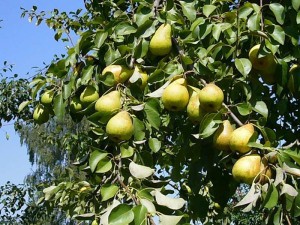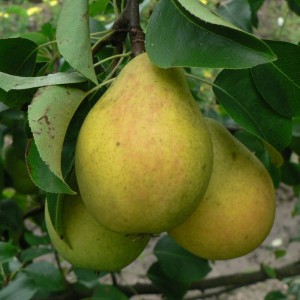Pear Lada - description and photo of the variety
Pear Lada was bred by a group of researchers from the Moscow Agricultural Institute, by crossing the popular varieties Lesnaya Krasavitsa and Olga. It is grown mainly in central Russia. Among gardeners, it has a positive review, it is especially appreciated for its high, regular yield and excellent quality of fruits, as well as unpretentiousness in care and resistance to rather low temperatures.
Content
Description
Pear Lada belongs to the early summer variety. The tree is medium-sized, standard, with a pyramidal or funnel-shaped crown, medium thickening. The bark is dark gray or gray; it is light brown on young, slightly curved shoots. Shoots of medium thickness, long, with few lenticels, without pubescence. Leaves of a rich dark green color, medium size, curved along the central vein of an oval-elongated shape, smooth, shiny. The petiole is 1.5-2.5 cm long, the stipules fall early.
The flowers are medium, cupped, collected in inflorescences of 5-8 pieces. Fruits are medium or medium small, weighing 100-115 g, with a smooth, shiny surface, obovate. The skin is thin, light yellow with a faint light red blurred blush. Subcutaneous points are almost invisible. The peduncle is short, 1.8-2.2 cm, the funnel is absent. The number of seeds in a seed box is up to 4-5 pieces. The pulp is whitish-yellow in color, granular, medium-dense, medium juiciness, has a sour-sweet taste and a weak, not pronounced aroma. However, the fruits of the Lada pear are distinguished by a high content of sugars, titratable acids and P-active substances. Lada belongs to early ripening varieties, however, the fruits do not crumble and weigh on the branches for a long time, at a temperature of 0-5 C they can be stored for 55-65 days.
In the photo below you can see the shape of an adult pear tree, what ripe fruits look like.

Advantages of the variety
Pear Lada belongs to self-fertile varieties, and brings a significant yield even when planted in a single quantity in the garden. However, the proximity of such pollinating varieties as Rogneda, Severyanka, Otradnenskaya, Chizhovskaya or Kosmicheskaya, makes it possible to significantly improve the quality of fruits and increase the fruiting of both varieties.
One of the clear advantages of this pear is its very high and regular fruiting. Lada is fast-growing and already 2-4 years after budding can bring a full harvest. With proper care, regular feeding and pruning, more than 45-50 kg of pears can be harvested from an adult tree annually. In addition, this variety has a high winter hardiness. Even young trees planted in the fall can easily survive the winter without shelter. Also pear Lada is highly resistant to many diseases, such as scab or fire blight.
This pear does not have significant drawbacks, since it is not whimsical in its care and generously thanks the owners for their care. Its only drawback is the low transportability of the fruits and the short period of their consumption.

Planting and leaving
The pear fret is not whimsical to soils, however, fruiting will be maximum when planted in chestnut, chernozem, loamy, gray forest or soils with a light texture, in any case, they should be structural, fertile, with good drainage. Therefore, on depleted, structureless soils, fertilizer is applied in a larger amount than in normal cases.
Lada is very sensitive to a lack of organic fertilizers, in a short time the tree can get sick and weaken, which can lead to its death during severe winter frosts.
This variety has a low drought resistance, therefore, the pear should be watered infrequently, but abundantly throughout the summer. She especially needs moisture in May-July during the period of active growth and during the pouring of fruits. As a rule, the application of fertilizers - potassium salts, superphosphates, nitrogenous and humus, is combined with irrigation. At the same time, at least 2-3 buckets are introduced under each tree, if the pear is an adult, the number of buckets for a single watering should be 4-5. The first feeding is carried out before flowering, then during flowering and when not large ovaries appear.

Although the Lada pear needs good lighting, it should be shaded in hot, dry summers, since the tops of the shoots and young leaves can turn black and dry under intense solar insolation. Regular spring pruning also allows you to increase the yield and taste of fruits. At the same time, old, dead, unnecessary, thickening branches are removed, thus forming its correct and symmetrical shape. Annual chemical treatment will help protect the tree from many pests and common diseases.
Video "Pear Lada - how to increase the yield"
The video below tells about simple and affordable methods of increasing the yield of this pear variety, the intricacies of pruning and feeding features.
